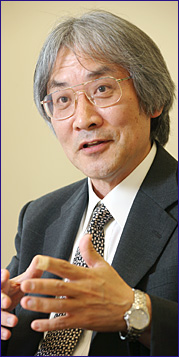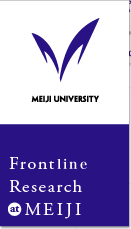

“Asakusa was Tokyo’s foremost entertainment district from the Edo period through to World War II,” says Professor Soichiro Itoda. “All of the other main downtown areas, such as Shibuya, Shinjuku and Ikebukuro, have developed since 1945.”
The professor, whose specialty is German literature, argues that Asakusa has played a unique historical role in terms of the comparative development of Tokyo as an international city.
“Asakusa is well known as an international tourist destination, but there had been no significant collaborative research on the area,” he says. “To remedy this, Tokyo’s Taito Ward and Meiji University launched a joint project to promote Asakusa within Japan and overseas, positioning Asakusa as a topic for international research.”
Meiji University and Taito Ward concluded an agreement on cooperation in November 2007. Since then, symposia and lectures have been organized to enable researchers from around the world to study and discuss Asakusa in greater depth.
Asakusa was the Center of Entertainment
Millions of Japanese and many foreigners who have visited Japan know Asakusa as an exotic shitamachi (downtown) locale that is popular with tourists for its emotional appeal. Originally, however, the place played quite a different role.“In its early days, Asakusa was a strongly religious site with the Sensoji temple dedicated to Kannon, the goddess of mercy. There were many artisans and craftsmen in the area. Kuramae, a quarter to the south of Asakusa, was also a major distribution center during the Edo period. So Asakusa was a nexus for religion, commerce and distribution,” explains the professor.
Today, most of the hustle and bustle in Asakusa is confined to the places featured in tourist guidebooks, notably the Kaminari temple gate and the long row of shops on the approach to Sensoji known as Nakamise. Long ago, however, the entire Asakusa district mixed the sacred and the profane within a dynamic mix of religion and economy that attracted many. The people demanded entertainment and a quarter full of theaters, sideshows and other places of entertainment sprang up on the western side of Sensoji.
“Today it may be difficult to imagine such a colorful urban environment, but these kinds of sideshows were once an integral part of all the world’s major cities, including London, Vienna and Berlin,” says Professor Itoda.
For those academics keen to do comparative studies of the world’s major cities, Tokyo’s Asakusa district provides a unique resource for studying the historical development of an area.
Significance of Establishing International Asakusa Studies
Previously, although individual researchers from Japan and overseas studied topics related to Asakusa, there was no forum for international collaborative research.Starting in 2001, Meiji University began organizing symposia jointly with the University of Vienna in Austria (alternating the venue between the two countries). Based on the success of these events, the two universities established the International Asakusa Research Project in 2007 to form the nucleus for further collaborative research in the field.
This research focuses on comparing Tokyo with other international cities through the prism of the phenomena observed in the Asakusa district. It is strongly connected with urban studies, but also touches on topics in many other fields, including religious studies, cultural anthropology, folklore studies, literature, commerce and tourism.
The fascination of each researcher with the subject matter helps to shed light on Asakusa. For Professor Itoda, whose field is German literature, what is his connection with the area?
“My maternal grandfather was a member of the founding family of the Negishi impresario agency that put on musical performances in a style known as Asakusa Opera,” he says. “I have studied the theater in my research, but it is difficult to research dramatic performances without also studying the venues where such performances took place.”
Professor Itoda was interested in studying the historical development of the theater in Berlin, London, Vienna and Tokyo. Besides studying the theater for its literary and artistic merit, he also decided to study the impact of theater on social structure. This led him into the realm of urban studies with the theater as the main focus of his research.
Asakusa Helps Fashion an Urban Theory for Tokyo
In studying the historical development of Tokyo as a city, it is striking that, compared with other international cities, Tokyo exhibited distinctive cultural aspects during pre-modern times, but the nature of this culture then changed as the city expanded into its modern form.During Tokyo’s pre-modern age, the Tokugawa shogunate placed a great deal of importance on Asakusa. According to Professor Itoda, the layout of Edo’s streets was heavily determined by feng shui considerations. Since Asakusa was deemed to be in an unlucky direction from this perspective, the shoguns took great care to protect Sensoji because they thought that it provided an essential bulwark against evil spirits entering Edo.
Asakusa thus became a gateway district. Following the relocation of the three principal kabuki theaters (the Nakamura-za, Ichimura-za and Morita-za) to Asakusa, the area began to flourish as the heart of merchant culture within Edo.
Even in the modern era, Asakusa continued to grow as a symbol of mass-market entertainment and fashion. Asakusa Opera was an entertainment style that showed off the area’s potential.
By creating a hybrid art form combining classical opera with music and dance in a Japanese style, Asakusa Opera helped to popularize Western music in Japan.
“Unlike the Imperial Theater, which showcased traditional Western opera, the major achievement of Asakusa Opera was that it provided a cheap and easy way for young people and the general public to enjoy musical numbers presented in a popular style,” says Professor Itoda.
In the Meiji and Taisho periods before the Great Kanto Earthquake of 1923, Asakusa was home to almost half of all the theaters in Tokyo. It inspired and led popular culture. It was the symbol of modernism, as epitomized by the Ryounkaku—the first high-rise building to be constructed in Tokyo, and also the first building in Japan with an elevator (the building was destroyed in the earthquake). Novelists, including Junichiro Tanizaki and Yasunari Kawabata, as well as other artists, used to stroll through the streets of Asakusa Rokku (Sixth), the famous theater district where the original would mingle with the vulgar. Asakusa became the source of many new literary ideas.
Professor Itoda comments, “The old Asakusa was a true entertainment district that people would stroll around to find pleasure, to escape from daily life. Today, while many tourists visit the area, most of Asakusa has declined in prosperity because it has lost this atmosphere.”
Seeking Possible Avenues for Revival of Asakusa
In the case of London and Berlin, the center of gravity of each city did not move elsewhere. In Tokyo, however, the main entertainment district shifted from Asakusa to other areas.The reason was economic: once Japan’s economy entered its period of high growth, new entrants with large financial resources began eyeing the urban entertainment market. The emergence of Shinjuku and Shibuya as major rail termini prompted the redevelopment of the commercial, retail and entertainment spaces near these stations. Young people started voting with their feet, abandoning Asakusa for these new centers. In the process, the ability of Asakusa to set the cultural tone steadily diminished.
“Downtown areas fade much like old cells shrivel and die,” says Professor Itoda. “It’s a natural phenomenon. However, rather than just observing its decline, understanding the rise and fall of Asakusa from an international viewpoint can help provide an insight into a universal issue.”
The universal issue in question is the impact that an outflow of capital can have on an urban area in terms of the changes it forces on local entertainment and businesses. This impact extends not just to changes in the area’s external appearance, but also affects the values and way of life of local residents and visitors.
Asakusa has metamorphosed from an entertainment spot for the young into a place for foreign tourists. Academic studies of Asakusa from literary, artistic, cultural, religious and other angles, and the publication of related research, can evoke memories of Asakusa from an international perspective. In turn, this can aid in the area’s revival.
By collaborating with institutions overseas such as the University of Vienna and working with the local Taito Ward government to promote international Asakusa-related academic studies, Meiji University hopes to foster research with practical implications for the future. This is research infused with hope of new trends that could yet be born in Asakusa.
Recently the efforts of Professor Itoda to bring Asakusa closer to a foreign audience have spawned a new and exciting project. In October 2009 work began to build an on-line radio station for the intellectually curious. While the spectacles and otherworldly experiences of Asakusa may be gone, the Tokyo-Edo Radio Project at Meiji University aims to give them new life in the theatre of the mind. A series on the Asakusa geisha Norie is already attracting interest.
Work is also in progress to produce a street version - a talking map of Asakusa for the adventurous flaneur. The programs are produced in English and can be enjoyed at http://www.tokyoedoradio.org or on your iPod via iTunes (search for "tokyo-edo").
Profile
Professor Soichiro Itoda, Department of Literature, School of Arts and Letters,Head of the Research Planning Promotion Headquarters, specializing in modern German literature, Japan-Germany comparative cultural theory
Born in Tokyo in 1950. Graduated from the Faculty of Economics, Keio University in 1973. Completed a doctorate course in German Literature, Graduate School of Letters, Keio University in 1978. Conferred a Dr. Phil. degree by the Graduate School of Literature, RWTH Aachen University, Germany in 1988. Has been a research fellow at the Alexander von Humboldt Foundation since 1991. In 1975 became an assistant at the Faculty of Economics, Keio University, then worked as an assistant professor and professor and has been in current position since 1999. Outside the university, works as a director of the Gesellschaft Zur Förderung Der Germanistik in Japan.
Society memberships
Japanische Gesellschaft für Deutschstudien, Japanische Gesellschaft für Germanistik, Goethe Gesellschaft in Weimar, Immermann GesellschaftMajor publications and academic papers
Berlin & Tokyo – Theater und Hauptstadt (Munich, iudicium publishing house)Theorie und Praxis des literarischen Theaters bei K.L. Immermann in Düsseldorf 1834-1837 (Carl Winter Heidelberg University publishing house)
Kawabata Yasunaris Roman “Die Rote Bande von Asakusa” Ein Tokyoter Stadtviertel zwischen Schaulust
Eros und Verkleidung (Institute of Japanese Studies, University of Vienna)










